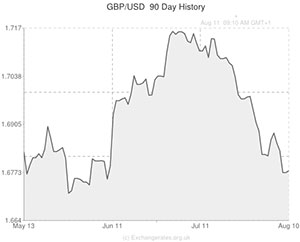
The Pound to US Dollar exchange rate (GBP/USD) weakened for the fifth week in a row last week as disappointing manufacturing and trade figures weighed on demand for Sterling.
With GBP/USD currently around three cents lower than it was midway through July – when the Pound struck a 5.5-year high – it looks as if Sterling’s bull run against the ‘Greenback’ could be coming to an end.
Between June last year and July this year GBP/USD rallied by over twenty cents from around 1.48 to just under 1.72 as the economic revival in Britain sparked an explosion of rate hike speculation.
Recent comments from Bank of England officials suggest that they consider the unemployment rate to be low enough and the CPI inflation rate to be high enough to warrant a tightening of monetary policy, but that they are concerned by the glaring lack of real wage growth.
With inflation running at 1.9% and average earnings only increasing by 0.3%, real wage growth is currently running at -1.6%. This is not good for the economy because it could lead to reduced purchasing power and therefore dampened consumer spending trends. Because private consumption is such an important part of the domestic economy – accounting for around 70% of GDP – it is crucial that the BoE doesn’t strangle economic growth with a premature rise in borrowing costs.
This means that the Pound could struggle against the US Dollar this week even if the British unemployment rate falls again on Wednesday. Analysts have pencilled in a small downtick from 6.5% to a fresh 6-year low of 6.4%. But estimates are far less optimistic regarding the rate of wage growth, which is expected to tumble to a fresh 5-year low of -0.1%.
GBP/USD is currently trading just below technical support close to 1.68 and could nosedive towards 1.67 if the average earnings numbers print inline with economists’ forecasts.
However, if the labour market report comes in slightly more enthusiastically than markets expect then it could drive GBP/USD back up above 1.68.
The Bank of England’s quarterly inflation report, released on Wednesday morning, could also have an impact on the Pound to US Dollar exchange rate. If the report shows that policymakers are overly concerned by Britain’s lack of wage growth then it could exacerbate the downward pressure on the Pound. On the other hand, if the report reveals that policymakers are keen to start the hiking cycle sooner rather than later then it could increase demand for Sterling.
UPDATED 22:35 GMT 11 August, 2014
GBP/USD Pushes Back Toward 1.68
The Pound to US Dollar (GBP/USD) exchange rate recovered some of its losses on Monday as investors rediscovered some of their appetite for higher-risk assets and investors focused on the UK’s upcoming employment figures and Bank of England (BoE) inflation report.
The GBP/USD pairing achieved a high of 1.6795 before returning to trend in the region of 1.6786.
Tomorrow the British Retail Consortium’s Like-for-Like Retail Sales report and the US Monthly Budget could cause fluctuations in the Pound Sterling to US Dollar (GBP/USD) exchange rate.

Comments are closed.